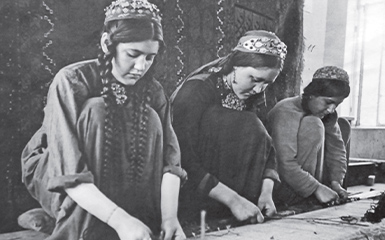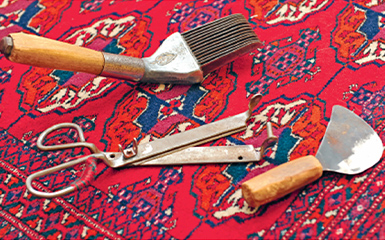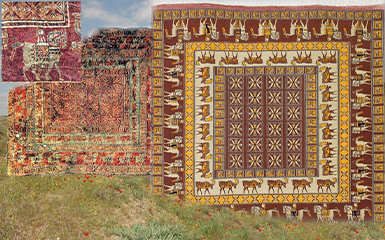Turkmen carpet is stronger than a stone and softer than a rose petal

Turkmen carpets had been an expensive commodity throughout the Great Silk Road and adorned the palaces of Asian and European monarchs for a long time. To date, they are priceless exhibits of the world’s largest museums, delighting tourists and art critics.
Turkmen carpets, unique in their refinement and beauty, are akin to the inspired music of the folk soul. Thus, the Turkmen people have a good reason to say, ‘Roll out your carpet, and it will show your soul’. The masterpieces of skilful craftswomen are full of mystery and magical perfection. Their beauty is the miracle of the hearth kept by the Turkmen women who continue the spiritual traditions.
Reflecting the heritage of previous epochs and the creative work of many generations, the Turkmen carpets captivate connoisseurs with the uniqueness of expressive means, the strict beauty of the ornaments and the harmony of colour combinations. The history of the Fatherland, art, writing and philosophy of the Turkmen people was reflected in the carpet gyols – the patterns and their semantic diversity.


Handmade carpet weaving has survived largely due to the fact that its secrets have been carefully passed down from generation to generation as a precious family treasure from time immemorial to this day. Popular wisdom says, ‘Water is the life, horse is the wings, carpet is the soul of the Turkmen people’.
The origin of the ornamental patterns of the Turkmen carpets is based on representing familiar things in a way that is true to life. The craftswomen have always reflected the reality, combining the ancient history and modern times in a stylized form in them. These patterns have a clear national colour and have not changed since ancient times.
Vivid colours are created thanks to the plant-based paints. Red – madder roots, yellow – turmeric roots, sophora buds, larkspur flowers and stems, grape leaves, blue – indigofera leaves (of various types). The buckthorn fruits give various colours – red, brown, yellow, green, etc.
Carpets met a variety of household needs. They provided the houses with heat insulation, served as furniture, cupboards, chests, cover for the household equipment, tribal signs and indicators of the family wealth. A bride provided carpets, which covered walls and floor, for new family as a dowry. Besides the carpets, the bride's dowry included the carpet-making tools, namely, a special knife called ‘keser’, combs for wool – ‘yun darak’, a beetle – ‘dokma darak’, scissors – ‘gezlik’.
The oldest Turkmen carpets had belonged to the late 18th century until recently. However, the method of radiocarbon dating revealed many works belonging to the late 15th-16th centuries. The earlier creations of the Turkmen craftswomen can be seen in the paintings of medieval artists. Moreover, there is a genuine existing message of the centuries. The Pazyryk carpet was created by the ancestors of the Turkmen people in the 4th century BC. To date, it is exhibited in the Hermitage, St. Petersburg.


A copy of the famous Pazyryk carpet is displayed in the world's only Carpet Museum in Ashgabat. This masterpiece was created by the modern heirs of the ancient art. They managed to tie 385 000 (!) knots in each square metre of the carpet, and 1 563 100 knots in total! Moreover, they are completely identical to those of the famous Pazyryk carpet. They say about such carpets, ‘stronger than a stone and softer than a rose petal’.
The secrets of this ancient craft have inspired a great number of artists for many millennia. The Turkmen carpet weaving has long been an integral part of world culture. In 2019, the traditions of Turkmen carpet weaving were inscribed on the UNESCO Intangible Cultural Heritage List.
To date, the Turkmen carpet is a national pride and a part of state symbols. Centuries pass by, epochs pass by, but time has no power against the beautiful masterpieces that glorified the home of carpet for centuries. The Turkmen carpet became a part of world culture, a bright symbol of the harmony of spirit, thought, faith, love and hope.
Carpet Museum